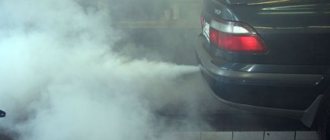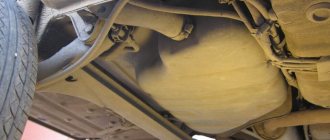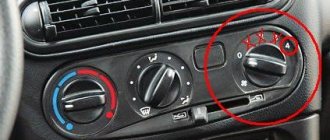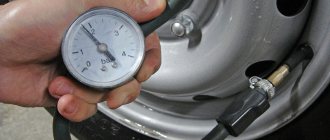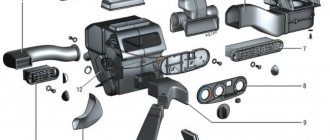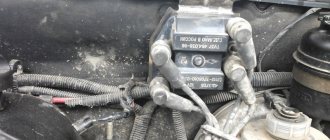Diagnostics
If the coolant leak is significant, the smell is accompanied by characteristic, wet spots under the heating system or pipes. In such a situation, identifying the malfunction will not be difficult. Additionally, rapid removal of antifreeze from the expansion tank will help. However, in the absence of physical traces, the procedure becomes a full-fledged quest. The liquid leaves in droplets, quickly evaporating, which makes it difficult to find a breakdown.
If the smell of antifreeze appears in the cabin when you turn on the heater, the search area is significantly narrowed. The reasons may be such factors.
- After replacing the radiator, the pipes are not securely fastened. Under weak clamps, when temperature and pressure increase, a gap may form. The breach allows antifreeze to leak out, where rapid evaporation occurs. Thus, there is a smell - there is no moisture.
- Defective or worn heater radiator. If a part develops a microcrack, locating the location is problematic. In this case, the liquid is released in minimal quantities, which makes it impossible to establish the breakdown point. However, this is enough to create a thick aroma.
- The hose is cracked. If the pipes are used for a long time or there was initially a manufacturing defect, a crack may appear on the body of the line. Typically, searching for a broken area is accompanied by bending and kneading the hose - thin holes may not be visible if the part is in its normal position.
Indirectly, the appearance of a persistent aroma of antifreeze provokes breakdowns outside the cabin.
- Leaks in the engine compartment. Some car enthusiasts point to antifreeze dripping onto the surface of the exhaust pipe and catalyst. From there, the smell can be drawn into the interior of the car.
- Pump failure. Through a faulty pump seal, the fluid reaches the timing belt, where the antifreeze evaporates, causing a persistent sweetish odor.
- Inaccurate repair work may also be the cause. During the overhaul process, antifreeze may spill onto heated surfaces. In this case, the aroma will disappear on its own after the formula burns out.
conclusions
Timely monitoring of the operation of the air conditioning system, through the filter of which odors from the engine compartment penetrate, will help to reveal many of its mysteries. Remember, coolant leakage directly affects increased engine wear.
Do not mix cooling products from different manufacturers.
It leaves - antifreeze, antifreeze from the expansion tank. Just something complicated
Chevrolet Niva coolant leaks. What to do?
Chevrolet Niva solving the problem of expansion tank plugs part 1
Antifreeze is leaving, but there are no drips
All signs of a broken cylinder head gasket VAZ NIVA At all stages of head gasket failure
Where does the antifreeze (antifreeze) of VAZ, KALINA, PRIORA, etc. go? or how to check the cylinder head gasket.
Why does antifreeze throw antifreeze out of the expansion tank?
Where does antifreeze (antifreeze, coolant) go?
Where does antifreeze go?
According to the maintenance regulations for a Chevrolet Niva, the coolant should be replaced every 60 thousand kilometers.
Chevrolet > Niva
What to do
Initially, you need to divide possible events into 2 categories:
- 1. In motion;
- 2. On the spot.
If while driving the smell of antifreeze begins to appear in the interior of the Priora, you need to stop as quickly as possible in order to avoid serious consequences in the form of engine overheating, and open the windows. In most cases, it is impossible to repair a breakdown on site without the necessary funds. As a permanent item in the trunk for such a case, a special radiator sealant is recommended. With its help, it is possible to temporarily eliminate the problem, which will allow you to get to the garage or service center without incident.
And then, to the best of your ability, either carry out repairs yourself and replace the part, or seek help from specialists.
If, when igniting, there is a strong smell of antifreeze in the interior of the Priora, you need to look for the reasons. The first step is to turn off the ignition to avoid engine overheating. Next, carry out a superficial inspection of the car; if the whole problem lies in the clamps, simply tighten them. If the reason is more serious, repairs cannot be avoided.
Here, as in the previous case, there are 2 options. The first is to carry out the repair yourself, if the damage is minor and it can be easily fixed with your own hands.
The second is to seek help from professionals. However, a breakdown is not always found near service centers. It is more likely to find it outside the city, after a long journey. In this case, a visit from a service specialist will help. It’s worth noting right away that the price for services will be completely different, since it will include the time and complexity of the road, the specifics of the upcoming work and the way back. Therefore, in some cases, it is easier to simply call a tow truck that will deliver the car to a service center, or at least to the nearest city.
It is impossible to completely eliminate the possibility of this breakdown, but it is quite possible to minimize the risks. To do this, you just need to use high-quality antifreeze, change it regularly, and inspect the car according to the instructions.
Heater malfunctions on Niva Chevrolet
Replacing the radiator of a Chevrolet Niva stove with air conditioning is quite a difficult job, but at the same time it can be done independently. Just first you need to determine whether the cause is really in the heater radiator. Symptoms of malfunction are as follows:
- Poor operation of the stove;
- Regular lack of fluid in the heating system;
- The appearance of an antifreeze smell in the cabin (not always);
- A puddle of greasy liquid under the driver's mat (at the same time, read the article on how to dry it).
Just in case, before you climb to the stove, check the hoses and pipes supplying liquid to it. If they are wet, then that's the reason.
Tool. This work does not require any special tools; almost everything you need can be found in a regular set of keys. You will also need 2 screwdrivers (slotted and Phillips) and pliers. And also a box for screws. In addition, you can stock up on markers.
The causes of the malfunction can be listed in a small list:
- A breakdown of the control unit has occurred.
Mechanical or operational damage to the radiator surface.
- Failed additional resistor.
- Radiator pipes damaged by external factors or worn out by prolonged use.
- Faulty heater valve.
How to determine what kind of breakdown occurred? Let's look at several different signs by which you can determine the cause of the malfunction and understand where to start repairing the stove.
Solving the problem of odor in the cabin
Actions that need to be taken to get rid of unpleasant odor in the car interior:
- Open the hood of the car and inspect all hoses, pipes and covers for cracks and chips.
- Check the tightness of all components and parts through which antifreeze may leak.
- Inspect all lids for the presence of various new growths. Also inspect the bottom of the car to make sure there are no antifreeze leaks.
- If the vapors do not disappear for a long time, then you should inspect the system responsible for heating the car cabin.
In order to avoid problems with antifreeze vapor leaking into the cabin in the future, it is necessary, first of all, to periodically check the coolant level in the radiator. If the amount of antifreeze becomes less than the required amount, then add it to the required level or carry out a complete replacement. Carry out general vehicle diagnostics as often as possible
and correct any problems immediately.
Try to use antifreeze of the class recommended for use in the technical specifications for the car, and do not mix coolers from different manufacturers.
Removing the smell of antifreeze from the interior
First you need to dry the wet areas. Absorbent mats are great for this purpose.
The presence of antifreeze under the driver's mat is considered one of the common causes of the “odor.” Liquid leaks from cracks in pipes are subject to evaporation, causing a specific “aroma”. These mechanical problems can be eliminated by replacing all inlet and outlet pipes.
The antifreeze collection diaper showed itself to be excellent!
The smell is eliminated by dry cleaning, ozonation, deodorization and long-term ventilation of the interior.
Replacing the cooling radiator
We inspect for leaks.
The smell is caused by an old, faulty (not removed) heater radiator, where some antifreeze remains. As the liquid evaporates, it inevitably becomes a scourge of the cabin air. Eliminating this begins with disassembling the unit and eliminating defects.
The reason for replacing the heater radiator is the presence of cracks, breakages of the side tanks, tubes, often aluminum.
The leakage of odor from the engine section, caused by leaking pipes when the engine is warm, allows antifreeze vapors to enter the passenger compartment. It can be eliminated by inspecting the cooling system and eliminating defects.
Causes
There are a large number of reasons why water gets into the interior of a Priora, which can lead to damage to the cooling system, pipes and radiator.
Let's consider the main ones:
- 1. Poor quality or unlicensed antifreeze, which can lead to destruction of the system from the inside;
- 2. Use of water instead of special coolant;
- 3. Lack of replacement or violation of the schedule for replacing coolant in the system;
- 4. Increased pressure in the cooling system, which leads to cracks;
- 5. Overheating of the system, which leads to boiling of the liquid and serious consequences for the system;
- 6. Normal wear and tear.
If at first glance, during a superficial examination, the reason is not visible, then it lies somewhere inside. To find out, you need to use the services of a professional and conduct a detailed diagnosis.
The interior smells of antifreeze Niva Chevrolet: where does the smell come from?
Niva Chevrolet. Personal experience. Heater radiator.
The smell is caused by an old, faulty heater radiator that has not been removed, where some antifreeze remains.
Following. Replacing antifreeze with antifreeze. Niva Chevrolet. Chevrolet Niva, interior improvements! - Duration: Rams.
The smell is caused by an old, faulty heater radiator that has not been removed, where some antifreeze remains. We know how to restore a car with minimal investment. Prolonged use of the car renders rubber gaskets, cuffs, and other non-metallic components unusable.
A sweet taste in the mouth is the first sign of an antifreeze leak. Either some Vitalik will call her, then she will call Vitalik... It’s a mess!
Chevrolet Niva 2006, 80 l. With. — self-repair
The process consists of warming up the engine, unscrewing the spark plugs and detecting the presence of antifreeze by smell.
The exact determination of the leak is checked by removing the cylinder head.
The presence of antifreeze in the crankcase oil is checked. Removing the smell of antifreeze from the interior First, you need to dry the wet areas. Absorbent mats are great for this purpose.
These mechanical problems can be eliminated by replacing all inlet and outlet pipes. The antifreeze collection diaper showed itself to be excellent!
The smell is eliminated by dry cleaning, ozonation, deodorization and long-term ventilation of the interior. Replacing the cooling radiator Inspect for leaks.
The smell is caused by an old, faulty heater radiator that has not been removed, where some antifreeze remains.
As the liquid evaporates, it inevitably becomes a scourge of the cabin air. Eliminating this begins with disassembling the unit and eliminating defects. The leakage of odor from the engine section, caused by leaking pipes when the engine is warm, allows antifreeze vapors to enter the passenger compartment. It can be eliminated by inspecting the cooling system and eliminating defects.
Self-diagnosis.
First of all, it is necessary to conduct a visual diagnosis of the cooling system. During diagnostics, it is necessary to carefully check all conductors of the system for mechanical damage or leaks. If damaged conductors were found during the inspection, it is necessary to restore the tightness of the cooling system by replacing them.
It is important to regularly monitor the temperature in the system!
Also, one of the most common malfunctions of the cooling system is coolant leakage into the engine crankcase. This malfunction can lead to quite serious consequences and significantly disrupt the function of the engine. This malfunction can be identified by visually inspecting the oil tank cap. If coolant enters the crankcase, a white emulsion appears on the cover. If coolant leaks out, you may notice a formation under the car.
If the inside of the car smells like antifreeze, then coolant leaks directly into the interior. The smell of antifreeze in the cabin indicates a leak in the heater core. If the radiator leaks, some of the coolant leaks directly into the passenger compartment and the driver of the vehicle may notice a characteristic sweet smell.
Also, coolant can get under the gas distribution mechanism drive. In this case, it is quite difficult to visually determine the leak, but by diagnosing the space under the timing belt, you can notice characteristic traces of moisture. As a rule, the cause of moisture formation under the timing belt is a faulty pump.
Cooling system
As you know, the combination of maintaining temperature conditions plays an important role in the proper and long-term functioning of the engine. If the cooling system malfunctions, the engine is subject to overheating and premature wear of the components. During vehicle operation, the cooling system operates in difficult conditions. System components are constantly exposed to high pressure and temperature changes. In this regard, the elements of the cooling system are subject to increased wear and require timely diagnostics and regular maintenance.
The smell of antifreeze in the cabin indicates a malfunction of the connecting hoses of the systems and the need for diagnostics. With prolonged use of the vehicle, the rubber components of the system wear out and often become unusable. If diagnostics have shown the maximum permissible wear of the system conductors, they must be replaced. To secure the cooling system hoses, it is best to use special metal clamps, which are characterized by a long service life, reliability and do not allow leakage of the working mixture.
In addition, it is necessary to pay attention to the condition of the radiator and, if necessary, restore its tightness or replace it
Add antifreeze
If there is a coolant leak, the car engine is subject to increased wear. In this regard, if you do not pay attention to the condition of the cooling system in a timely manner, you can end up with a large number of engine repair costs. Timely diagnostics and regular maintenance of the cooling part will allow you to remain confident in the reliability of the engine and increase the service life of its elements.
https://youtube.com/watch?v=_iBZedCKcMs%3F
Good luck!
Antifreeze under the driver's mat on a Chevrolet Niva
He reeks of fumes a mile away. Secondly, I told you a long time ago that the draft from the door was blowing into my back, therefore, I couldn’t smell it. And thirdly, what if this is your drinking companion, and then should I be the extreme one? A manifestation of this is the broken seal of the heater radiator, its hoses and clamps.
The location of the leak can be determined by visual diagnostics, which reveals mechanical defects in pipes, connections, and tightness of hose fastenings. A sweet taste in the mouth is the first sign of an antifreeze leak.
This is evidenced by the engine temperature sensor going off scale. As a result, the coolant boils, coming out of places with weak connections. The situation becomes more complicated when a smell appears when the stove is running, which does not exclude the fact that there is a malfunction of the leaky heater core. Antifreeze leaking from under the receiver gasket. Prolonged use of the car renders rubber gaskets, cuffs, and other non-metallic components unusable.
They need to be replaced urgently, and secured with reliable metal clamps. The cause of the smell is also considered to be the expiration date of the antifreeze. Over time, the liquid ages and loses its frost resistance under the influence of environmental pressure and temperature changes.
Effective cooling of the engine, preventing its boiling, and preventing corrosion remains the main function of the liquid.
A temporary improvement in the properties of antifreeze is the effect of diluting it in proportion 3: Malfunctions and symptoms A serious problem is the leakage of antifreeze into the engine sump.
A malfunction of this kind is accompanied by the appearance of a white coating on the oil tank cap.
Antifreeze leak in shnivo
The leakage of antifreeze leaves a puddle under the car. Characteristic marks and spots of moisture are often found on the timing belts. The pump is leaking. The reason for this is a possible malfunction of the pump, although it is difficult to determine such an assumption visually.
Malfunction of the coolant tank plug. Antifreeze leaking from the expansion tank. In this case, the smell will appear when the stove and ventilation in the cabin are turned on. Under the hood, characteristic traces of leaks from the expansion tank will be visible. Malfunction of the antifreeze circulation system. Malfunction of the coolant circulation system leads to a change in the temperature regime of the engine.
Niva – Club / Niva – Club
This is facilitated by severe high-pressure conditions and temperature changes in which antifreeze circulates. And this is a compelling argument for rapid wear of interfaces and premature failure of the vehicle. Cases of decreased antifreeze levels have a right to exist.
Where does the liquid go if there are no signs of external leakage?
What should a car enthusiast do?
First of all, carry out a complete diagnosis of the car's cooling system. This can be done in the garage, without complex devices and without special knowledge and skills. But you need to carefully remove the smell of antifreeze. Open the hood, check the pipes, hoses and covers for visible damage. Absolutely all system conductors must be checked. We replace damaged parts.
Another cause of a leak may be a malfunction in the engine crankcase. Failure leads to disruption of the functionality of the power unit. To diagnose, just look at the oil tank cap from the inside. If coolant gets on the engine crankcase, a white coating forms on the cover.
As a result of the leak, coolant can penetrate directly into the passenger compartment. This indicates a malfunction of the radiator. If a leak forms in it, some of the coolant penetrates into the cabin, where a characteristic sweetish smell is felt. We replace the radiator with a new one and remove the liquid. This can be done by placing newspapers on the puddle, which we throw away as they become soaked. Someone uses a plastic bottle. We make a hole in its lid, then squeeze the bottle to release air from it and apply the hole to the spilled moisture. In 3-4 passes, you can “suck out” the entire puddle in this way, and wipe off the remaining moisture with a rag.
The cause of the leak can be difficult to determine. If the source of suspicious traces cannot be identified, look at the radiator of the heating system. Coolant may also leak from the heater. Then an unpleasant burning smell is felt in the cabin. Leaking liquid will get under the mat. To fix the problem, you will have to replace the stove radiator by first disassembling its body.
The reason may not be in the radiator itself, but in the tubes connected to it. The joints can be treated with sealant. But it is better to immediately replace the problematic tubes with new ones.
To prevent the appearance of coolant vapors in the cabin, you need to check the level in the radiator from time to time. The evaporated liquid should be replenished, and if the evaporation is too intense, the cause of the problem should be urgently determined.
On thematic forums, it is advised to use the coolant of the brand that is recommended for use in your specific car model. It is not recommended to mix coolers of different types. Timely diagnostics of the cooling system will allow you to identify faults and increase the service life of the power unit elements.
Advice for car enthusiasts. Coolant replacement
Nowadays, no motorist can do without coolant. After all, without this substance, even the most powerful machine engine will not last long. But what is the best type of cooler to buy? Moreover, car stores now have a huge variety of different
Chevrolet-Niva heating system: replacing the interior heater heat exchanger
Recommendations for replacing the interior heater radiator on a Chevrolet Niva car without air conditioning, the main stages of the process.
How to determine malfunctions of the Lada Samara 2113 thermostat and replace it yourself
Many who spend most of their time on the road might have seen a car standing on the side of the road with clouds of steam escaping from under the hood. At the same time, even ordinary people who are far from the design of engines understand that this indicates problems in the cooling system, and more “advanced” ones will also point out
The Passat engine overheats: what to do?
The vehicle's cooling system is designed to maintain engine operating temperature. To do this, it includes several important devices, which will be discussed. If one of the components fails, the engine may overheat, which will lead to its failure. By car Volkswagen
How to remove the heater radiator yourself and not freeze in your Zhiguli car?
If you have fallen on hard times and it is not possible to contact a car repair shop or service center, or you are convinced that you should take care of your car yourself, and the time has come to replace the heater radiator of your VAZ 2109, do not despair, do not be scared and read this article carefully. Before
Leaks and problems
When replacing the coolant, you should inspect all pipes and connections for possible problems. After all, when the fluid is drained, it is easier to replace them than to tear them during operation. You need to pay special attention to the clamps; for some reason, many people use ordinary worm clamps. Over time, they squeeze the hoses, causing them to break.
In general, the Chevrolet Niva has several main problems related to the cooling system. It often happens that antifreeze leaves the expansion tank. The plastic on it constantly bursts, which causes leaks. In this case, replacement will be required.
Another problem is antifreeze under the driver's mat, which can cause a sweetish smell in the cabin and also fog up the windows. Most likely the culprit will be a leaking heater radiator. This problem is usually referred to as “a chef’s nightmare.”
There is also a situation where antifreeze is thrown out of the expansion tank. This may indicate a broken cylinder head gasket. This is checked as follows. With the car completely cooled down, remove the expansion tank cap, after which you need to start the engine and rev it up intensively. It is advisable to have a second person so that he can see whether the antifreeze in the tank will bubble at this time.
About a month ago, the antifreeze began to disappear little by little; diagnostics revealed a crack in the expansion tank. Yesterday I finally fixed everything. So, to replace the tank and antifreeze, we will need: Expansion tank 200 rubles Two clamps 50 rubles Antifreeze 10 kilograms (in my case SINTEC ULTRA G11 red) 750 rubles.
Tool: Phillips screwdriver Ratchet with 13mm head and extension. Funnel for pouring antifreeze into the tank (can be cut from a bottle) Place the car on a relatively flat surface, let the antifreeze cool (I did it on a cold one). We open the cap of the expansion tank (many people recommend opening the stove for hot airflow, but as far as I remember, there is no stove tap in the shnivo, there is only a damper, and the stove radiator is always in the system).
Then we remove the plastic roof from the engine to make it more convenient to work. We stop near the left headlight and look down and in the left corner of the radiator under the fan we see (or feel with our hand) a plastic lamb. The photo should make it clear where to look for it.
We unscrew and try not to lose the rubber gasket, because... the pressure at the beginning is decent (be careful, you can get burned with hot antifreeze!) in my case, the gasket remained perfectly in place...
After draining the radiator (DO NOT put the plug back), look at the cylinder block immediately behind the ignition module (for those who have it in a standard place) in the photo along the arrow:
Unscrew it counterclockwise using a 13 mm socket and a ratchet with an extension. The spark plug wire of the third cylinder may be in the way, feel free to remove it!
After the antifreeze stops flowing, you can press on the hoses going to the radiator to expel the residue, and then put everything back together in reverse order, replacing the tank in one go.
First, the plug in the block (it does not have a washer) is tightened onto the cone. Then the radiator cap. Pour in antifreeze through a funnel.
After everything that can fits in, we begin to press on the radiator hoses, pushing the rest into the system. Then, without covering the tank with a lid, we warm up the car until the fans turn on and add antifreeze to the mark. After the car has warmed up and the antifreeze has been filled in, you need to check everything for leaks, check the operation of the stove and leave the car overnight, and then add a little more antifreeze... In general, that’s all. P.S. I didn’t flush the system and in vain, the antifreeze became dirty after an hour. But it doesn’t affect the speed and that’s okay
